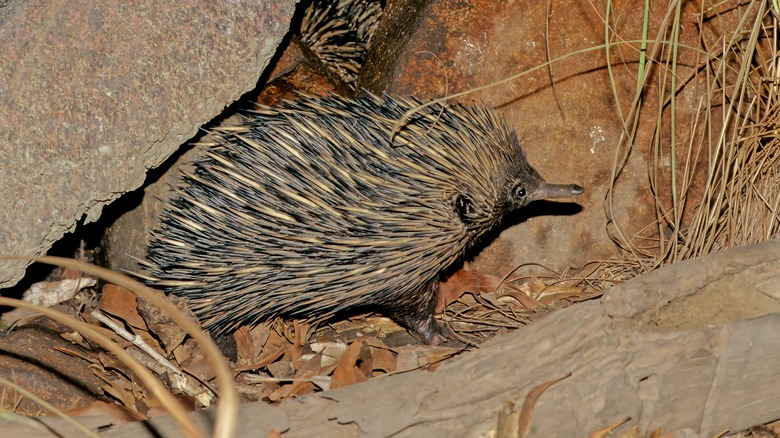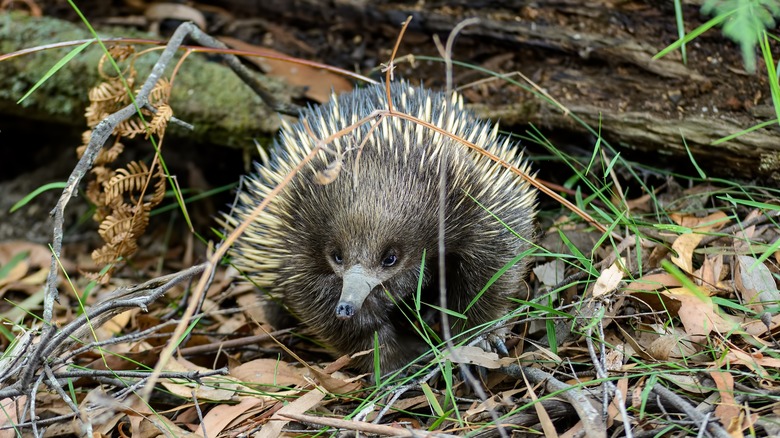The Gross Way Echidnas Keep Cool In The Australian Heat
Our world is a truly remarkable place. This is the reason so many of us feel the urge to travel: to see and experience more of it. Meeting new people, trying new food, being joyfully terrible at a new activity ... for those with wanderlust, this is the essence of the human experience.
For keen travelers around the world, Australia is a common bucket list destination. It's easy to see why, too: the country is the proud host of natural wonders like Uluru. Also known as Ayers Rock, per Britannica, the sandstone monolith is a sacred and imposing sight, and its unique composition causes its hue to change throughout the day under the influence of the Sun.
Needless to say, the Sun tends to be available in no short supply in Australia. We humans, luckily, have developed a range of convenient tools to help combat this issue, from simple handheld fans to formidable air conditioning units. The other flora and fauna of Australia have their own cunning tricks in that regard, too, and the echidna's phlegmy approach is as creative as it is revolting.
Beating Australia's legendary heat
The sheer Australian heat can't be oversold. In December 2022, per the Guardian, a heatwave saw Western Australia and the surrounding region reach temperatures of around 45 degrees Celsius (112 degrees Fahrenheit).
Across the country, the temperature can differ a lot. Tourism Australia reports that the average maximum temperature in Hobart in the summer in January is 71 degrees Fahrenheit, while in Darwin it's as high as 89 degrees Fahrenheit. In the notoriously-scorching outback, meanwhile, the BBC reports that the heat can rise far above 104 degrees Fahrenheit.
Heat mitigation, in short, is vital. The animals of Australia have a range of approaches to this. Emma Malik of Wild Life Sydney Zoo told ABC News in 2016, " You can always tell when a lorikeet is hot because you will find them panting and opening up their wings." Kangaroos, meanwhile, use their own saliva to keep themselves cool, as they don't sweat, the outlet goes on.
The lick method of cooling is a little messy. It's nothing compared to what the echidna does, though. According to Science News, these spiky little souls blow snotty bubbles with their noses, coating their faces with phlegmy grossness. It sounds like standard dinnertime etiquette for any human toddler, but this technique actually helps cool the creature down (the echidna, not the toddler). Here's how.
The heat is snot a problem for these clever creatures
The January 2023 study "Postural, pilo-erective and evaporative thermal windows of the short-beaked echidna (Tachyglossus aculeatus)," from Christine Elizabeth Cooper and Philip Carew Withers (via Biology Letters), explains this curious behavior.
The scientists state that said echidna species seems to be able to resist higher temperatures than its biology suggests it should. It was reportedly believed that, as echidnas don't sweat, lick themselves like kangaroos or any other such behavior, they appear to simply avoid the sun during the hottest times, "switch[ing] to primarily nocturnal behaviour during summer." The study attempted to determine whether the booger-bubbles echidnas blow contributed to a "thermal window," defined as "regions of an animal's body surface that vary heat exchange with the environment, being 'opened' or 'closed' by changes in exposure and/or blood flow."
Infrared thermography observation of echidnas in Western Australia determined something fascinating: They were going about their days at temperatures above what was believed to be deadly to them. The temperatures topped this limit by 36.32 degrees Fahrenheit, too. How were they doing this? Thanks to the power of snot, it seems.
Said snot bubbles evaporate in the heat. In doing so, per the study, "the beak tip, containing a large dorsal blood sinus, is kept moist to facilitate electroreception ... An additional role of this moist surface is evaporative cooling of the underlying blood within the sinus."


